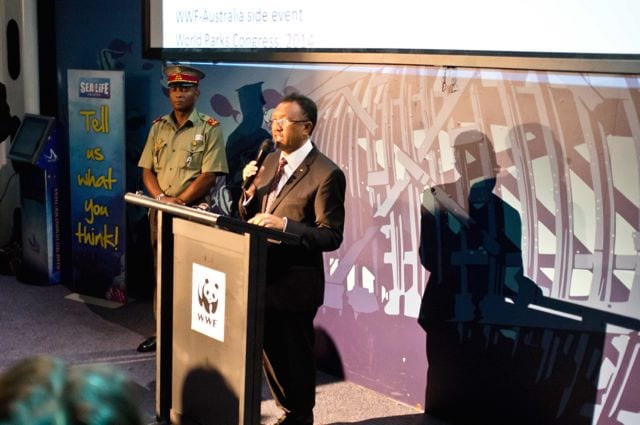By Vatosoa Rakotondrazafy, MIHARI Network coordinator
In November 2014, during the World Parks Congress in Sydney, His Excellency the President of the Republic of Madagascar Hery Rajaonarimampianina announced an ambitious commitment to triple Madagascar’s marine protected areas in the next ten years. This presidential engagement forms part of the commitments made by many other countries and stakeholders under the banner of the “Promise of Sydney”.
In Madagascar, Locally Managed Marine Areas (LMMA) were highlighted as an important option to be considered in the tripling. However there are some challenges that hinder their contribution to meeting this target, such as the lack of a specific legislative framework for the governance of these LMMAs and the limited capacity management of these communities.

A year has passed since the announcement in Sydney. The community of marine and coastal conservation in Madagascar, in collaboration with the Government of Madagascar launched a process to coordinate the practical aspects of delivering this promise through the establishment of a steering committee involving a wide range of stakeholders and government ministries. The MIHARI Network had the opportunity to join this committee. As the coordinator of the network, I was honoured to represent the voices of 128 LMMA communities and their supporting organisations at the first meeting of the steering committee that was held February 18, 2016. The main objective of the network in participating in the steering committee is to highlight the potential and capacity of LMMAs in delivering the Promise of Sydney, as well as the vital necessity to consider fully the essential role and experiences of LMMA managers and the realities on the ground in the initiatives and decisions taken forward.

After nearly a decade since the term was first used in Madagascar, LMMAs can be considered as one of the pillars of Madagascar’s marine and coastal resource management. Given the challenges in managing Madagascar’s marine resources in a country with 5600 km of coastline, and severely under-resourced state services, LMMAs are seen as having the greatest potential to expand marine management. The LMMA approach ensures communities are at the center of decisions; they are the main actors in the management of their resources. They are consulted first in the various activities developed in the area that they manage. Their proximity to their managed LMMA gives them a sense of ownership of those coastal areas, which motivate them in protecting and preserving their own resources.

Existing LMMA initiatives already covering over 12 000 km2 of Madagascar’s coastal shelf, and many more communities are interested in the approach, giving great potential for geographic expansion. However, with the exception to the five MIHARI sites that obtained the status of MPA under Madagascar’s system of protected areas, the rest of LMMAs are managed either by the Dina or by management transfer (under the GELOSE framework). Areas governed by these legislative frameworks alone cannot contribute to the Aichi target 11 as protected areas, or the presidential commitment for the Promise of Sydney. But with the right technical support for the managers of these LMMAs and changes to policy to recognise these resource management efforts, we believe that many of these sites could fulfill the requirements to contribute to the Government’s engagements.
Given the strong potential of LMMAs to contribute to the increase of marine areas under protection, we are collaborating with policy makers to ensure that the initiatives undertaken towards delivering the Promise of Sydney reinforce the support to LMMAs, improving their effectiveness and potential for the management of marine and coastal resources. We propose therefore that measures should be taken to facilitate the contribution of LMMAs in this presidential commitment. Improving the policy framework for LMMAs has been recognised as a priority in delivering the promise. We are advocating for the implementation of a "bottom-up" approach and take into account the realities on the ground and consultation of all stakeholders in the process, especially coastal communities. This should secure LMMA managers’ user rights and management rights, and strengthen governmental support and commitment towards LMMAs.
The meeting of 18 February was a successful meeting for the MIHARI network. I am optimistic that the support from the Malagasy government to LMMAs, especially in terms of “legislation” will help build the effectiveness of these LMMAs and contribute to realising the promise of Sydney. MIHARI is always honored to work with the Malagasy government to increase support for LMMA communities. This is a joint commitment of all stakeholders in marine conservation and management. The meeting ended with the acknowledgment of LMMAs as advocated by MIHARI to facilitate "legalisation", "formalisation" and "recognition" of LMMAs and enable them to achieve the promise of Sydney.


